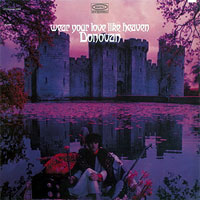Donovan • Wear Your Love Like Heaven
 rom the moment I heard Donovan Leitch sing "Colour sky
Havana, colour sky rose carmethene," on the Speakers Corner reissue of Wear Your
Love Like Magic, I could almost smell the patchouli incense wafting from his
flower-draped recording studio. But this recording is more than just a psychedelic swirl.
Ever the innovator, Donovan had already sworn off drugs and turned
to transcendental meditation by the time the album debuted. Almost as much as the
50th-anniversary remaster of the Beatles’ Sergeant Pepper’s Lonely Hearts
Club Band, this release enables you to travel back in time to when you could actually
say "groovy" with wide-eyed sincerity. rom the moment I heard Donovan Leitch sing "Colour sky
Havana, colour sky rose carmethene," on the Speakers Corner reissue of Wear Your
Love Like Magic, I could almost smell the patchouli incense wafting from his
flower-draped recording studio. But this recording is more than just a psychedelic swirl.
Ever the innovator, Donovan had already sworn off drugs and turned
to transcendental meditation by the time the album debuted. Almost as much as the
50th-anniversary remaster of the Beatles’ Sergeant Pepper’s Lonely Hearts
Club Band, this release enables you to travel back in time to when you could actually
say "groovy" with wide-eyed sincerity.
Wear Your Love Like Heaven was initially released in July of 1967 as the first disc of a UK double album called A Gift From a Flower to a Garden, but Epic label head Clive Davis worried that four sides of peace, love and understanding might be a bit much for American consumers. So Wear Your Love Like Heaven, named after the opening track, was repackaged and released in the US with a psychedelic infrared Karl Ferris cover photo of Donovan lounging in a boat in front of Bodiam Castle. Turns out Davis’s fears were unfounded, and the double LP made it to number 19 on the US charts. I happen to think the best music from those sessions is on the US release anyway. The 25-year-old Donovan dedicated this album to young parents, and it certainly paints an idyllic portrait of the kind of world he hoped the new generation could create, one family at a time. It should come as no surprise that idealism like that attracted its share of eye-rolling from cynics. But the obvious creativity and inspiration on this disc also help explain why artists like the Beatles took Donovan seriously and actually benefited from his musical influence. Not long after this album's release, John Lennon acknowledged using Donovan’s fingerpicking style on songs like "Happiness is a Warm Gun" and you can hear the Scotsman’s jaunty, carefree style winding its way through a number of Paul McCartney’s more whimsical tunes. While a couple of tracks like "Oh Gosh" can sound a bit precious and dated, Wear Your Love Like Heaven stands out because of its embracing of the real feelings some people had in 1967 about the future. Most of the songs are utterly original and addictively sweet. Offbeat lyrics as well as the tapestry of harpsichord, B3 organ, bongos, acoustic guitar, flute and vibraphone prove that Donovan loved to experiment. Nihilists won’t get it, but this is an album that can make just about anyone smile. The quality of this reissue is in keeping with Speakers Corner's legendary standards. Original analog tapes have been used for cutting the lacquers, and the entire process used for creating this record was free of any digital effects. The results on my turntable are luxuriously black backgrounds (due to the Pallas pressings), exceptional dynamics and three-dimensional presentation of images. As with many albums of the period, a number of cuts are
plagued by instruments being panned hard left or right in the mix. However, the utterly
natural richness of the recording makes those engineering decisions a very minor
distraction. I had only heard a scratchy dollar-bin version of the US pressing several
years back, so the effect of listening to the Speakers Corner reissue reminded me of the
time I watched the fully restored print of Rear Window: I knew the movie was a
half-century old, but it still seemed utterly present and new. Vinyl this good makes it
hard to return to digital files. |
